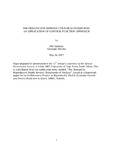| dc.contributor.author | Ajakaiye, Olu | |
| dc.contributor.author | Mwabu, Germano | |
| dc.date.accessioned | 2013-07-05T14:29:33Z | |
| dc.date.available | 2013-07-05T14:29:33Z | |
| dc.date.issued | 2007 | |
| dc.identifier.uri | http://www.africametrics.org/documents/conference07/Day%203/Session%208/Mwabu%20THE%20DEMAND%20FOR%20REPRODUCTIVE%20HEALTH%20SERVICES.pdf | |
| dc.identifier.uri | http://hdl.handle.net/11295/45875 | |
| dc.description.abstract | Ou Ajakaiye, AERC, Nairobi, email: olu.ajakaiye@aercafrica.org
Germano Mwabu, University of Nairobi, email: mwabu@kenyaweb.com
Problem statement. Sub-Saharan Africa has the worst indicators of reproductive
health in the world. Reproductive health indicators such as maternal and infant
mortality rates are highest in this region. Low birth weight is a summary indicator
of reproductive health but its determinants are not obvious. We use the control
function approach to investigate the determinants of low birth weight on the basis
of which we propose policy interventions.
Research Methods. We employ a control function approach to estimate the effect
of tetanus vaccination on birth weight using cross-section data from Kenya. A
structural model of birth weight determination is estimated under the assumption
that tetanus vaccination is complementary to health inputs and behaviours that
improve birth weight, namely: prenatal care, food supplements, and behavioural
change during pregnancy. The first-stage regression estimates the reduced form
parameters of a demand function for tetanus vaccination in which instruments for
vaccination include money- and time-prices of health services. The effect of
sample selectivity on the estimated structural parameters in the second-stage
regression is also investigated because birth weight is censored.
Results and conclusion
We find that birth weight is positively associated with tetanus vaccination. This
association is indirect as it comes from the hypothesized complementarity between
vaccination and birth weight. Consistent with the previous literature (Dow et al.,
1999), the complementarity hypothesis cannot be rejected with the Kenyan data.
However, disaggregation of data by mother’s residence and income suggests that
the complementarity effect on birth weight is driven by unobserved variables, such
as mother’s knowledge of essential health services and behaviours that enhance
birth weight. Policies to promote such care and behaviours are discussed in a
concluding section. | en |
| dc.language.iso | en | en |
| dc.title | The demand for reproductive health services: an application of control function approach. Paper prepared for presentation to the 12th annual conference of the African Econometric society, 4-6 July 2007, university of cape town, South Africa. This is a distillation from our earlier joint work, entitled, “the demand for Reproductive health services: frameworks of analysis”, issued as a framework Paper for the collaborative project on reproductive health, economic growth and poverty reduction in Africa, AERC, Nairobi. | en |
| dc.type | Article | en |
| local.publisher | School of Economics, University of Nairobi | en |

